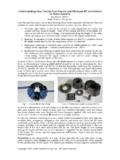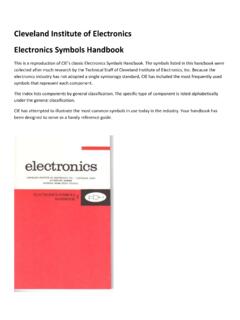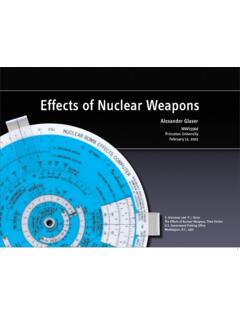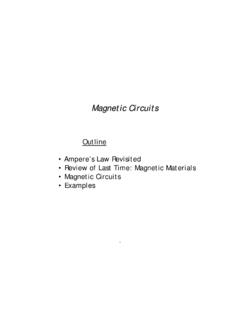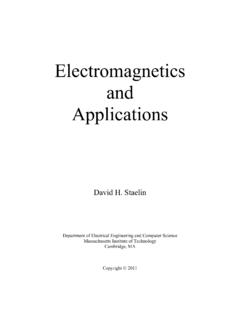Transcription of Betatrons - MIT
1 Betatrons32611 BetatronsThe betatron [ Kerst, Phys. , 841 (1940)] is a circular induction accelerator usedfor electron acceleration. The word betatron derives from the fact that high-energy electrons areoften called$-particles. Like the linear induction accelerator, the betatron is the circuitequivalent of a step-up transformer. The main difference from the linear induction accelerator isthat magnetic bending and focusing fields are added to confine electrons to circular orbits aroundthe isolation core. The beam acts as a multi-turn secondary. A single-pulsed power modulatoroperating at a few kilovolts drives the input; the output beam energy may exceed 100 MeV. Themaximum electron kinetic energy achieved by Betatrons is about 300 MeV. The energy limit isdetermined in part by the practical size of pulsed magnets and in part by synchrotron principles of the betatron are introduced in Section The similarities between thepower circuits of the linear induction accelerator, the recirculating induction linear accelerator,and the betatron are emphasized.
2 An expression is derived for the maximum energy from abetatron; neglecting radiation, the limit depends only on the properties of the ferromagnetic areas of accelerator physics must be studied in detail in order to understand the betatron;the theory of particle orbits in a gradient-type magnetic field and properties of magnetic orbits, the simple theory of betatron oscillations introduced in Section must beextended. The amplitude of transverse-orbit oscillations and conditions for constant main-orbitradius must be determined for highly relativistic particles in a slowly changing magnetic treats main orbit equilibria. The main orbit in the betatron has a constant radiusBetatrons327during the acceleration cycle. The orbit exists when the well-knownbetatron conditionissatisfied. The confinement properties of the system for nonideal orbits are derivations demonstrate two properties of orbits: (1) particles injected on a circular orbitinside or outside the main orbit approach the main orbit during acceleration and (2) theamplitude of transverse oscillations decreases during the acceleration cycle.
3 Section the first effect, motion of the instantaneous circle. Section discusses damping ofrelativistic betatronoscillations during acceleration. As an introduction, Section reviews the properties ofperiodic particle motions under the influence of slowly changing forces. The laws governingreversible compressions, both for nonrelativistic and relativistic particles, are discussed. Theresults are applicable to a wide variety of accelerators and particle confinement devices. covers injection and extraction of electrons from the surveys betatron magnet circuits, proceeding from simple low-energy devices tohigh-energy accelerators with optimal use of the core. The betatron magnet provides fields forparticle acceleration, beam bending, and particle confinement. The magnet must be carefullydesigned in order to fulfill these functions simultaneously. Ferromagnetic materials are anintegralpart of all Betatrons except the smallest laboratory devices.
4 Thus, the available flux change islimited by the saturation properties of iron. Within these limits, the magnet circuit is designed toachieve the highest beam kinetic energy for a given stored modulator with good magnet design, existing Betatrons are inefficient. Conventional Betatrons relyon gradients of the bending field for focusing and utilize low-energy electron injection. Theself-electric field of the beam limits the amount of charge that can be contained during thelow-energy phase of the acceleration cycle. Usually, the beam current is much smaller than thedriving circuit leakage current. Consequently, energy losses from hysteresis and eddy currents inthe core are much larger than the net beam energy. Efficiency is increased by high beam strategies for high-current transport are discussed in Section The two most promisingoptions are (1) addition of supplemental focusing that is effective at low energy and (2)high-energy electron injection using a linear induction accelerator as a preaccelerator.
5 Inprinciple, Betatrons can produce beam powers comparable to linear induction accelerators with aconsiderable reduction in isolation core PRINCIPLES OF THE BETATRONF igure illustrates the basic betatron geometry. A toroidal vacuum chamber encircles thecore of a large magnet. The magnetic field is produced by pulsed coils; the magnetic flux insidethe radius of the vacuum chamber changes with time. Increasing flux generates an azimuthalBetatrons328electric field which accelerates electrons in the the absence of an air gap, there is little magnetic flux outside the core. An air gap isincluded to divert some of the magnetic flux into the vacuum chamber. By the proper choice ofgap width, the vertical magnetic field can be adjusted to confine electrons to a circular orbit inthe vacuum chamber. As shown in Figure , the confining field lines are curved. Theresultant field has a positive field index. As we found in Section , the field can focus in boththe horizontal and vertical summary, the simple betatron of Figure has the following elements:1.
6 A pulsed magnet circuit to accelerate electrons by inductive An air gap to force magnetic field into the beam transport region; electrons follow circularorbits in the bending Shaped magnetic fields for beam first glance, the betatron appears quite different from the linear induction , we can show that the power circuits of the two devices are similar. To begin,consider the induction accelerator illustrated in Figure The geometry is often called arecirculating induction linac. The transport tube is bent so that the beam passes through thesame cavity a number of times. This allows higher beam kinetic energy for a given volt-secondBetatrons329 Betatrons330Eb'VotpNc/2BR(eV).( )Eb#2 BsNAcc/2BR.( )Eb#2 BsRc/2.( )product of the isolation cores. The transport. tubes are made of metal; each cavity has separatevacuum insulators and high-voltage feeds. There are supplemental magnetic or electric forces tobend the orbits and keep particles confined in the begin, we calculate the maximum electron kinetic energy possible in a recirculatinginduction linac with the following assumptions:1.
7 The beam tube has circumference There areNcavities around the circumference; each cavity has an isolation core withcross-sectional accelerating waveform in a cavity is a square pulse with voltageV0and the most of the acceleration cycle, electrons travel near the velocity of the acceleration cycle, the electrons makerevolutions and travel throughctp/2 BRcavities. The final kinetic energy is thereforeNctp/2 BREquation ( ) can be rewritten by expressing the volt-second product in terms of the coreproperties [Eq. ( )]:For a given circumference, the highest energy is attained with the tightest packing of isolationcores around the beam tube. The packing limit is reached when the cores fill the area inside thebeam,. Making this substitution, we find thatNAc'BR2An optimized recirculating induction accelerator with pie-shaped cores is shown in Figure the figure, much of the structure has been removed and the vacuum insulators have beenextended to produce a single nonconducting toroidal vacuum chamber.
8 The final step is torecognize that the radial currents of the individual power feeds cancel out; we can replace themultiple voltage feeds with a single line that encircles the core. Power is supplied from asingle-pulse modulator. The resulting geometry, the power circuit of the betatron, is shown inFigure summary, the main differences between the betatron and the linear induction accelerator areas follows:1. The betatron has one pulse modulator; the induction accelerator has )b'(eV0/2BR)2E)b/mi)t.( )dE)b/E)b '(V0/2BR)2e2/mi)t.( )2. The beam in an induction accelerator makes a single pass through the machine. Theequivalent circuit is a transformer with a single-turn secondary and multiple parallel primarywindings. In the betatron, the beam makes many revolutions around the core. The circuitrepresenting this machine is a single primary with a multi-turn Because of recirculation, average gradient is not a concern in the betatron.
9 Therefore, lowaccelerating voltages and relatively long pulselengths (matched to the available volt-secondproduct of the core) are used. The circuit of Figure requires a slow voltage pulse because ithas significantly higher inductance than the driving circuits of Fi re Shaping of the voltage pulse shape is not important in the betatron. The beam is distributeduniformly around the transport tube; there is no need for longitudinal confinement. The betatronmagnet is usually driven by a bipolar, harmonic voltage waveform that cycles the core between -Bsand + slow acceleration cycle and small circuital voltage allow a number of options forconstruction of the transport tube. The tube may be composed of metal interrupted azimuthallyby one or more insulating rings. It is also possible to use a metal chamber constructed of thinstainless steel; the wall resistance must be high enough to keep inductively driven return is also applicable to the betatron.
10 As an example of kinetic energy limits, takeR=1mandBs= T. The maximum kinetic energy is less than 450 MeV. Equation ( ) hasan important implication for the scaling of betatron output energy. The beam energy increaseslinearly with the radius of the central core, while the volume of core and flux return yokeincrease asR3. Cost escalates rapidly with energy; this is one of the main reasons why betatronsare limited to moderate beam a final topic, we shall consider why Betatrons have little potential for ion acceleration. Inthe discussion, ion dynamics is treated nonrelativistically. Assume an ion of massmiis containedin a betatron with radiusR; the emf around the core isV0. The energy ions gain in a time interval)tiseV0multiplied by the number of revolutions, orEquation ( ) can be rearranged to giveIntegrating Eq. ( ) (with the assumption that the final ion energyEbis much larger than theinjection energy), we find for the volt-second product and assuming a core areaBR2, Eq.











